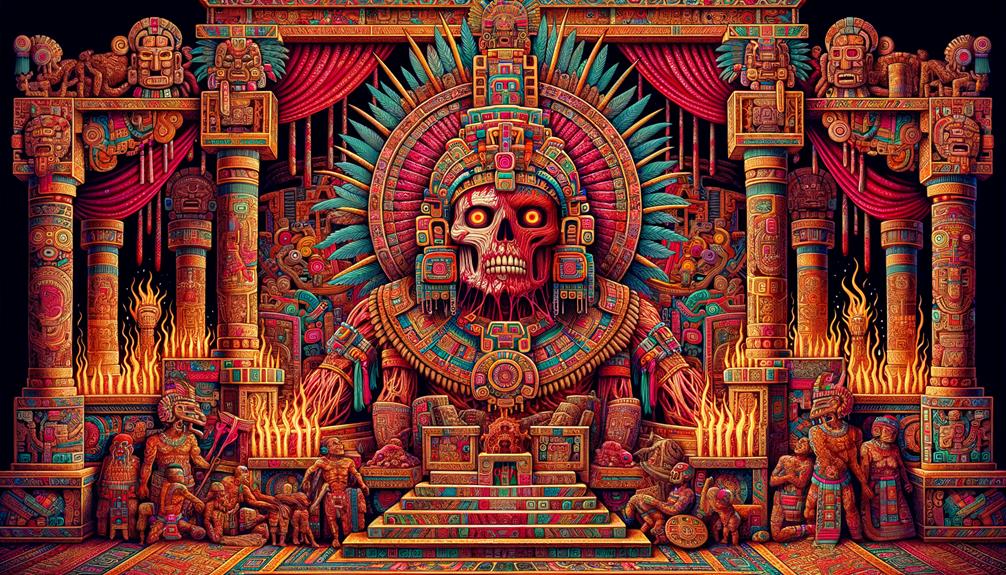When I first came across Xipe Totec, the Flayed God in Aztec mythology, the symbolic depth struck me. This deity dons sacrificial victims' skin as a grisly yet powerful second skin, embodying the brutal yet vital cycle of death and renewal. The flayed skin transcends a gruesome accessory; it symbolizes transformation, shedding the old to birth the new. Examining rituals honoring Xipe Totec makes me ponder how these ancient practices shaped the Aztec worldview.
Origins and Etymology
The name Xipe Totec, meaning 'Our Lord the Flayed One,' perfectly captures this deity's role as a symbol of rejuvenation in Aztec mythology. This Flayed God represented nature's cycles – life blossoming from death. His name reflects how shedding old skin signifies rebirth.
Xipe Totec's influence extended to agriculture. As vegetation sheds and regrows, the Flayed God embodied spring's renewal. His myth involves an eternal cycle – death breathes life into the next generation. As crops die and sprout anew, Xipe Totec promises constant regeneration. Understanding his origins illuminates his profound power within Aztec beliefs.
Attributes and Depictions
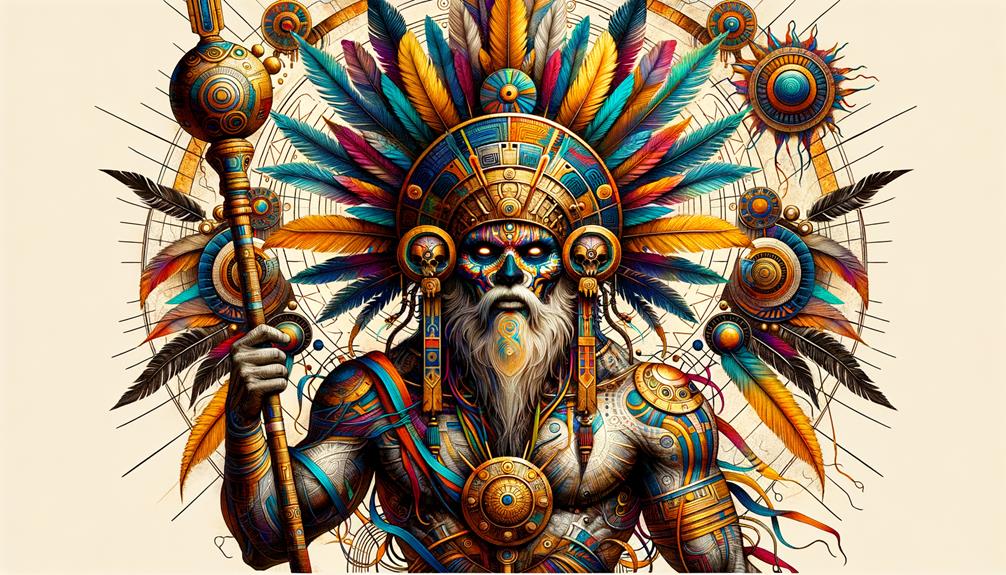
Xipe Totec's haunting appearance, draped in flayed human skin, personifies the Aztec belief in the cycle of death ushering in new life. This formidable deity confronts us with both terror and profound symbolism. Often depicted wearing sacrificial victims' flayed flesh, Xipe Totec embodies the paradox that destruction precedes renewal. His presence reminds us that the Aztecs saw death as a necessity for rebirth.
Artistic depictions of Xipe Totec feature:
- Sunken eyes and swollen facial features, enhancing his unsettling countenance.
- Human skin robes, illustrating the renewal process.
- Hands and feet of sacrificial victims dangling from his skin garments.
- Statues and masks capturing his eerie yet vital role in the cosmic cycle.
- Juxtaposing decayed flesh with growth symbols, highlighting his dual nature.
As an archetypal figure of transformation in the Aztec pantheon's mythological journey, Xipe Totec signifies the profound link between death and rebirth by wearing the skin of the sacrificed.
Symbolism and Meaning
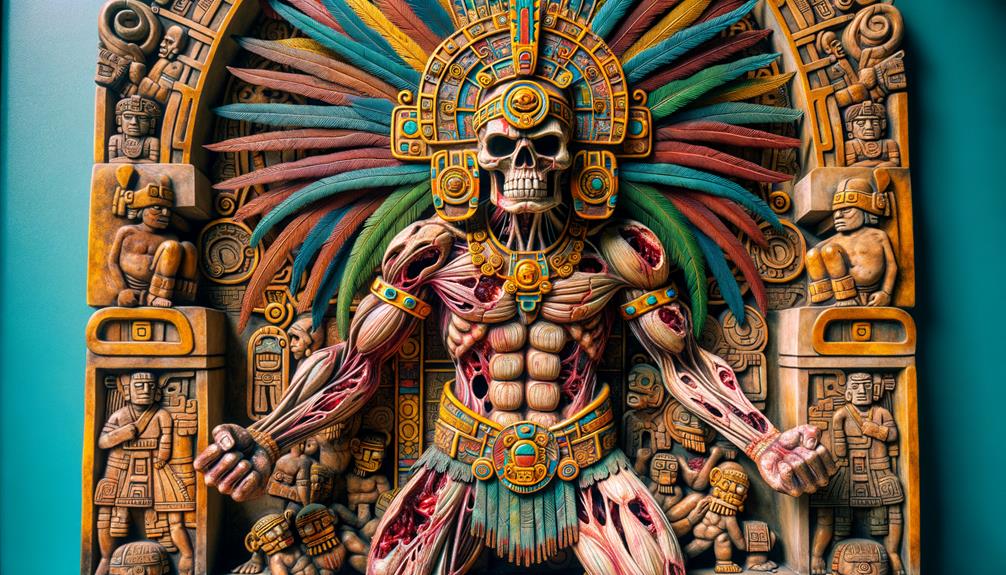
Gazing upon Xipe Totec's unsettling visage, we unravel the profound symbolism interwoven with his flayed skin, revealing the Aztec belief in sacrifice as a catalyst for renewal. In Aztec mythology, Xipe Totec personifies the intricate cycle of life and death, a divine agent catalyzing rebirth and regeneration. His flayed skin, a visceral depiction of shedding the old to embrace the new, stands as a powerful symbol of transformation and growth.
Xipe Totec's connection to spring and the revival of vegetation highlights his role in coaxing life from death's embrace. This cyclical pattern is fundamental to comprehending the Aztec worldview, where life and death intertwine inextricably. The deity's flayed skin not only signifies sacrifice but also heralds rebirth and fertility, vital elements for the agricultural society that venerated him.
| Aspect | Symbolism |
|---|---|
| Flayed Skin | Shedding old for new, transformation |
| Spring Association | Vegetation renewal, life from death |
| Agricultural Fertility | Renewal of natural world, growth |
| Sacrifice | Catalyst for rebirth and regeneration |
Thus, Xipe Totec's imagery and symbolism convey a profound message about the necessity of sacrifice for the cyclical renewal of life, solidifying his significance in Aztec mythology.
Rituals and Ceremonies
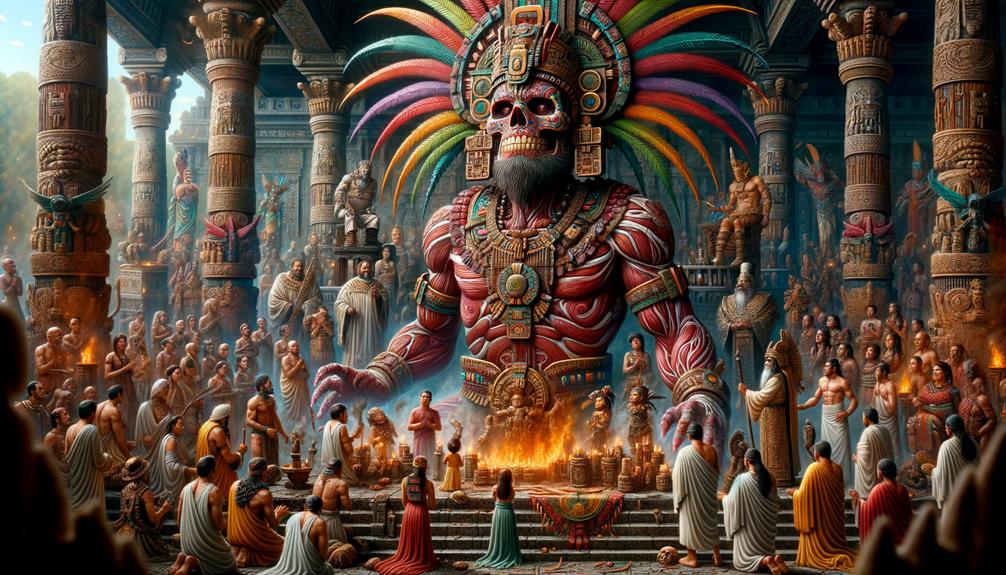
During the Tlacaxipehualiztli festival, flaying sacrificial victims vividly enacted the transformative power associated with Xipe Totec's mythology. This ritual emphasized death and renewal as pathways for life to flourish. The ceremonies intertwined symbolism and ritualistic acts representing agricultural cycles and human sacrifice.
Key elements included:
- War captives battled elite Aztec warriors in gladiatorial contests, symbolic of struggle before renewal.
- Priests wore dyed yellow skins of freshly flayed victims, embodying Xipe Totec's transformative aspect.
- Fertility rituals invoked fertile spring rains and vegetation renewal.
- Sacrificing victims, often war captives, honored Xipe Totec and secured agricultural prosperity.
- Flayed human skin symbolized shedding old layers for new growth and beginnings.
These flaying rituals weren't mere spectacles but profound Aztec worldview expressions. Believed through such sacrifices, they could honor Xipe Totec and maintain life's unbroken cycle.
Influence on Aztec Culture
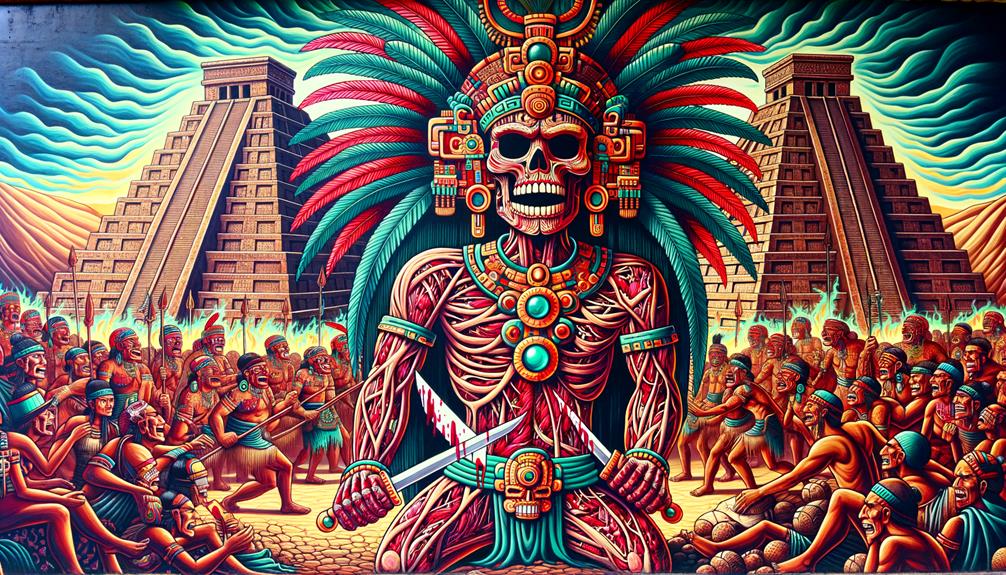
Tlacaxipehualiztli's gruesome flaying rituals paid homage to Xipe Totec but also infused the transformative power of nature into Aztec life itself. As spring's divine embodiment, Xipe Totec mirrored the agricultural cycles crucial for Aztec survival. His flayed skins symbolized shedding the old to embrace the new.
Human sacrifice during Tlacaxipehualiztli wasn't just religious theater – the Aztecs believed it ensured bountiful harvests. Sacrificial victims sporting flayed skins represented renewal, their deaths sustaining communal prosperity. This ritual highlighted the belief that rebirth demanded offerings to appease the gods.
Artistic renderings of Xipe Totec clad in sacrificial skins conveyed the profound death-rebirth concept. This archetypal imagery pervaded Aztec culture, with each spring affirming Xipe Totec's potency. The god's influence constantly reminded the Aztecs of the fragile life-death equilibrium ingrained in their spirituality and agricultural practices.
Frequently Asked Questions
What Type of God Was Xipe Totec?
Xipe Totec embodied the cyclical journey of life and death, symbolizing renewal through flayed skin rituals aligning with nature's rhythms. This ancient Mesoamerican deity represented rebirth and regeneration, connecting deeply to the world's recurring patterns.
What Are Some Myths About Xipe Totec?
One intriguing aspect is that Xipe Totec rituals involved flaying victims, symbolizing rebirth. Stories portray him as the archetypal hero undergoing transformative trials, where death leads to renewal. His symbolism mirrors agricultural cycles and the perpetual dance of life and death.
Was Xipe Totec the God of Springtime and New Crops?
Xipe Totec embodied springtime and budding crops. His flayed skin mirrored nature's cyclical renewal – the shedding of the old to make way for fresh growth, a vital process ensuring agricultural fertility and abundance.
What Did the Chief of the Aztec God Xipe Totec Wear?
During sacred rituals, the high priest wore golden garments adorned with the flayed skin of sacrificed individuals – a powerful symbol representing the cyclical nature of life, death, and rebirth. This gruesome act embodied the archetypal journey through transformation and renewal.

